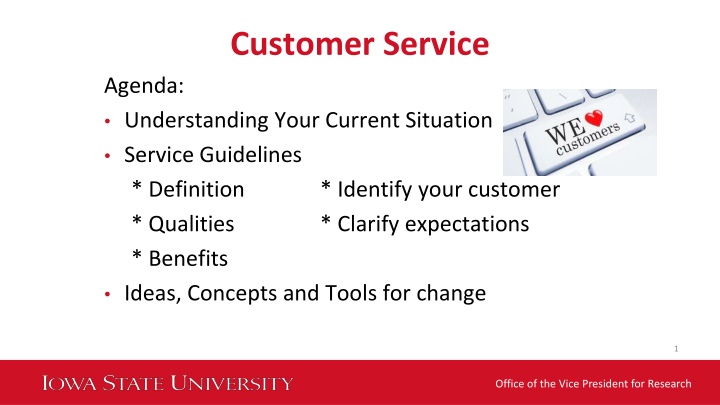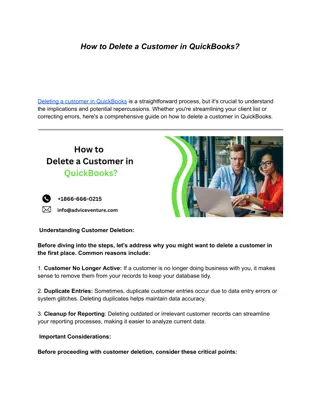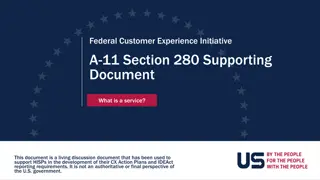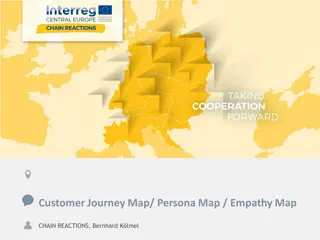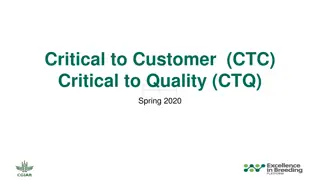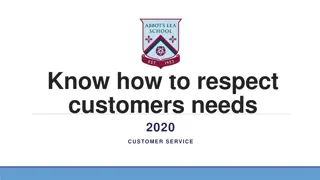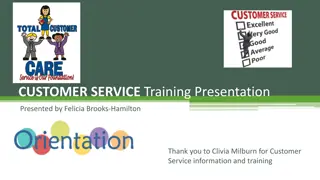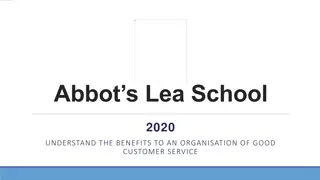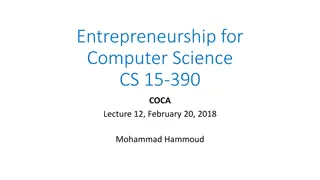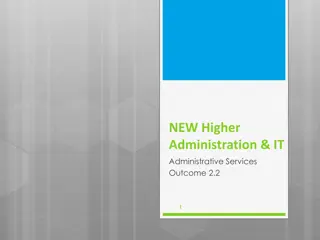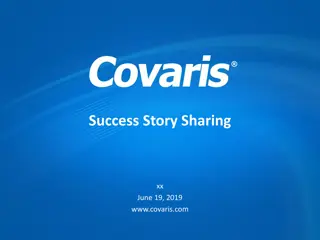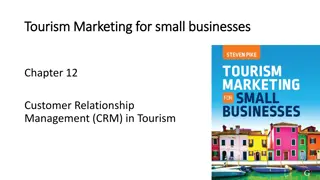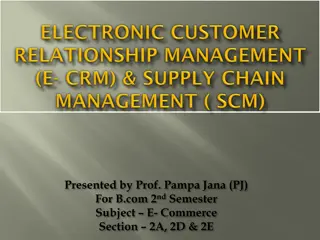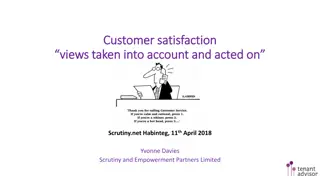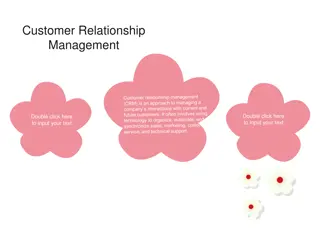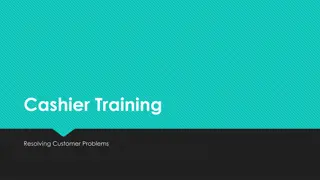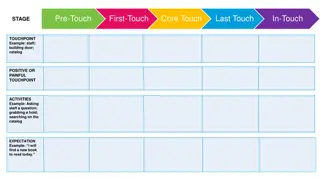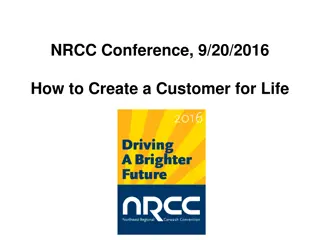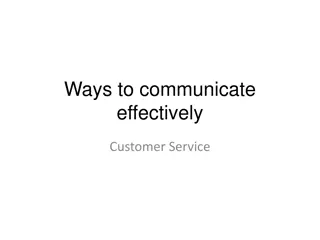Enhancing Customer Service: Strategies for Success
Understand your current service situation by defining customer service, identifying qualities, and exploring benefits. Discover ways to meet and exceed customer expectations while adapting to change. Enhance customer service to boost employee loyalty and productivity in your organization.
Download Presentation

Please find below an Image/Link to download the presentation.
The content on the website is provided AS IS for your information and personal use only. It may not be sold, licensed, or shared on other websites without obtaining consent from the author.If you encounter any issues during the download, it is possible that the publisher has removed the file from their server.
You are allowed to download the files provided on this website for personal or commercial use, subject to the condition that they are used lawfully. All files are the property of their respective owners.
The content on the website is provided AS IS for your information and personal use only. It may not be sold, licensed, or shared on other websites without obtaining consent from the author.
E N D
Presentation Transcript
Customer Service Agenda: Understanding Your Current Situation Service Guidelines * Definition * Qualities * Benefits * Identify your customer * Clarify expectations Ideas, Concepts and Tools for change 1 Office of the Vice President for Research
Current Service Situation What does ISU, as an employer, currently expect of you? Compliance? Policy? Rules? Guidelines? What does your customer expect of you? Are you meeting these expectations? Are you actively working to improve? Are these expectations changing? Are you adapting to these changes? Companies with strong service standards have employee loyalty, low employee turnover, and low productivity costs. 2 Office of the Vice President for Research
Service Guidelines How do you Define Customer Service? There isn't a right or a wrong definition. A large part of how you define it will determine what good customer service means to you. Examples 3 Office of the Vice President for Research
Service Definition Examples Customer service is the process of ensuring customer satisfaction with a product or service. Service that treats customers with a friendly attitude and tries to resolve their problem or question as efficiently as possible. Service is defined as meeting or exceeding the expectations of a customer. Customer Service is performing to the highest standards and measures, especially with consideration to quality metrics. 4 Office of the Vice President for Research
Qualities of Great Customer Service greeting the customer (either by phone or in person) questioning to understand the customer s need or problem listening, confirming understanding responding with value using positive language eliminating jargon concluding the interaction dealing with angry customers importance of body language and tone of voice 5 Office of the Vice President for Research
Some Benefits of Great Customer Service Good listening skills and questioning techniques can shorten the interaction time with customers. This allows an organization to serve more customers in less time. However, customers do not want to feel rushed, when they have questions. Be proactive and make sure every consumer feels they are being heard and not just "listened" to. Being able to clearly explain the next step in a process and confirming that the customer is satisfied, will decrease the number of callbacks and return customers. Improving "first contact" resolution is one of the primary drivers of customer satisfaction. 6 Office of the Vice President for Research
Some Benefits of Great Customer Service Training all employees using consistent customer service skills, allows them to have a common process and language when assisting customers. This allows the business to brand their interaction of excellent service to the customer, which adds value to the business. Investing in employee training gives employees a feeling of value and improves morale. In addition, when employees feel valued, they value their customers. This could be a result of effective customer service skills training, which not only benefits the employee, but will enhance the relationships with the customers. These important factors can help to increase employee loyalty, reduce employee turnover, and lower productivity costs. 7 Office of the Vice President for Research
Clarify Who Your Customer is The 20/80 Rule Applied to Customers "For many companies, 20% of the customers generate 80% of the profits. Those companies would often be better off by focusing more on that 20%, and by searching for other customers similar to that 20%... - Tom Murcko (Chief Executive Officer for Investorplace Media, LLC) Do you have regular customers you work with over and over? Are they clearly identified? How can the service provided to them become more effective and efficient? 8 Office of the Vice President for Research
Clarify Who Your Customer is The Customer is the Real Boss "There is only one boss. The customer. And he can fire everybody in the company, from the chairman on down, simply by spending his money somewhere else. - Sam Walton, founder of Wal-Mart If your customers had the choice, would they go somewhere else? Why? 9 Office of the Vice President for Research
What are your customers top service expectations? Speed? Knowledge? Accuracy? Courtesy? Are there metrics that go along with these? first response time? average response time? total handle time? 10 Office of the Vice President for Research
Ideas, Concepts and Tools for Change Great Service starts with your attitude, pride and ownership Start with idea of yes for the answer. If no , provide alternatives. 3E s: Energy; Execution; Enthusiasm 4P s: Promptness; Politeness; Professionalism; Personalization (use their name, etc.) Make it obvious that you care about the customer 11 Office of the Vice President for Research
Ideas, Concepts and Tools for Change Does your department have a mission statement? Vision Statement? Identified values? Can they be tied to service to explain the importance of service so the why is understood? Can service be tied to an employee s performance review? Added to their position description? 12 Office of the Vice President for Research
Ideas, Concepts and Tools for Change What other departments/individuals do you need to have close partnerships with? What can be done to improve/define/share processes? Improve relationships? Create Standard Operating Procedures? FPM? UHR? Another College? 13 Office of the Vice President for Research
Customer Survey Do your customers know you care and are wanting to improve? Appropriate questions; Effective questions Do a survey of your customers to see what they need develop questions from that feedback Measurable answers; scores (e.g. rate on a scale of 1 to 5) Categorize / group questions / answer scores Would be available to every customer, every transaction 14 Office of the Vice President for Research
Customer Survey Post results for everyone to see Bring them to meetings for discussion Recruit positive surveys Please fill out a survey and let us know how happy you were with our services Create Action Plans to raise scores Specific changes to make Follow up on changes make them habits Celebrate milestones / provide recognition Have contests, games, competitions, set team and individual goals 15 Office of the Vice President for Research
Ideas, Concepts and Tools for Change Be creative about service Think outside the box Brainstorm ideas make lists No idea is off-limits! 16 Office of the Vice President for Research
